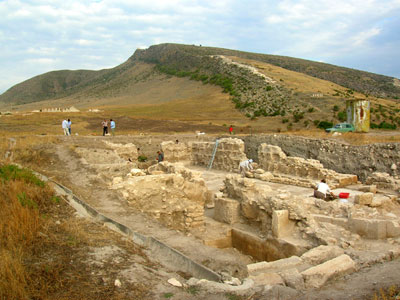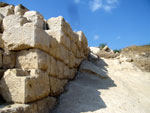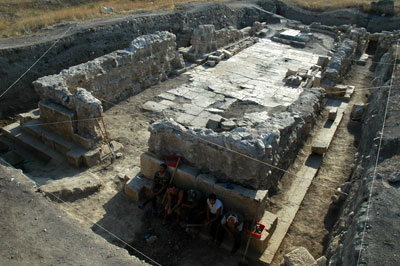Archeological Digs Continue at Artsakh’s Tigranakert Site
 Excavations at the Tigranakert site in Artsakh are on-going. The dig is being supervised by the RoA National Academy of Sciences’ Institute of Archeological and Ethnographic. The work, begun in mid-June and scheduled for completion at the end of this month, is being financed by the NKR government.
Excavations at the Tigranakert site in Artsakh are on-going. The dig is being supervised by the RoA National Academy of Sciences’ Institute of Archeological and Ethnographic. The work, begun in mid-June and scheduled for completion at the end of this month, is being financed by the NKR government.
 On August 7, a group of reporters was invited to take a tour of the site by Hamlet Petrosyan, who heads the Department of Cultural Studies at Yerevan State University. He filled the reporters in on the results of the dig. He explained that the work at Tigranakert was taking place at three different locations. The first spot we visited was the site of an early Christian basilica church, where excavations of the primary structure of the church is nearing completion. Mr. Petrosyan explained that one of the new results of this year was the unearthing of the church’s eastern obsidian external outline. This leads one to believe that the church’s original structure is much older; 4th-5th century. Silver coins dating to the 13th-13th centuries were unearthed during the dig at the church site. This attests to the fact that the site was still inhabited after the destruction of the church itself. Also unearthed were shards of glass vessels, of the early Middle Ages. Exaltation of the cross
On August 7, a group of reporters was invited to take a tour of the site by Hamlet Petrosyan, who heads the Department of Cultural Studies at Yerevan State University. He filled the reporters in on the results of the dig. He explained that the work at Tigranakert was taking place at three different locations. The first spot we visited was the site of an early Christian basilica church, where excavations of the primary structure of the church is nearing completion. Mr. Petrosyan explained that one of the new results of this year was the unearthing of the church’s eastern obsidian external outline. This leads one to believe that the church’s original structure is much older; 4th-5th century. Silver coins dating to the 13th-13th centuries were unearthed during the dig at the church site. This attests to the fact that the site was still inhabited after the destruction of the church itself. Also unearthed were shards of glass vessels, of the early Middle Ages. Exaltation of the cross  In the words of the team leader, the exaltation of the cross is quite evident at the church site as witnessed by a jug with the sign of an ascending cross and a piece of a small necklace also engraved with a cross. There are crosses to be found all around the church site as well. Also of note are the Armenian inscriptions. This year a fragment was found with the letter “Khe”. According to Hamlet Petrosyan, this is one of the earliest Armenian inscriptions in Artsakh and proves that the language was being used as early as the end of the 5th century or beginning of the 6th century. The second site we visited was the central citadel. Practically nothing remains standing and the primary cultural layer dates to the 4th-8th centuries. Further irregular construction at the site dates to the 12th-13th centuries. These include uneven walls and remnants of large jugs and “tonirs”. Inesa Karapetyan, a senior researcher at the Institute of Archeological and Ethnographic, told us that the upper level of the citadel at Tigranakert, according to preliminary assessments, served as one of the prime defensive positions and most probably hosed a large tower and expansive square. The antique layer of the citadel is being verified in spots where examples of colorful earthen fragments date to a few centuries before and after 1 AD. Various stamps and seals were also uncovered, embossed with deer and eagles, showing that Tigranakert wasn’t an average settlement but that it had commercial and administrative significance. 4th century B.C. agate seals
In the words of the team leader, the exaltation of the cross is quite evident at the church site as witnessed by a jug with the sign of an ascending cross and a piece of a small necklace also engraved with a cross. There are crosses to be found all around the church site as well. Also of note are the Armenian inscriptions. This year a fragment was found with the letter “Khe”. According to Hamlet Petrosyan, this is one of the earliest Armenian inscriptions in Artsakh and proves that the language was being used as early as the end of the 5th century or beginning of the 6th century. The second site we visited was the central citadel. Practically nothing remains standing and the primary cultural layer dates to the 4th-8th centuries. Further irregular construction at the site dates to the 12th-13th centuries. These include uneven walls and remnants of large jugs and “tonirs”. Inesa Karapetyan, a senior researcher at the Institute of Archeological and Ethnographic, told us that the upper level of the citadel at Tigranakert, according to preliminary assessments, served as one of the prime defensive positions and most probably hosed a large tower and expansive square. The antique layer of the citadel is being verified in spots where examples of colorful earthen fragments date to a few centuries before and after 1 AD. Various stamps and seals were also uncovered, embossed with deer and eagles, showing that Tigranakert wasn’t an average settlement but that it had commercial and administrative significance. 4th century B.C. agate seals  The third site we visited was the northern walls of the citadel. We were told by Vardges Safaryan, a member of the dig team and lecturer at Artsakh State University responsible for this section, that 25 meters of new wall were excavated this year to add to the 60 meters uncovered last year. Mr. Safaryan told us that the major find at this section has been the agate seals which date from the 4th century B.C. to the Hellenistic period. Samples of earthenware have been uncovered as well dating from a few centuries before 1 A.D. all the way up to the 12th-13th centuries. This attests to the fact that the site was inhabited during these periods. Then too, there’s the structure made of unfired brick that still needs to be studied in detail. According to excavation team leader Hamlet Petrosyan, carved out cliffs are clearly visible with living chambers. He says that excavations have reached a layer where new finds are always turning up. Museum is planned for site
The third site we visited was the northern walls of the citadel. We were told by Vardges Safaryan, a member of the dig team and lecturer at Artsakh State University responsible for this section, that 25 meters of new wall were excavated this year to add to the 60 meters uncovered last year. Mr. Safaryan told us that the major find at this section has been the agate seals which date from the 4th century B.C. to the Hellenistic period. Samples of earthenware have been uncovered as well dating from a few centuries before 1 A.D. all the way up to the 12th-13th centuries. This attests to the fact that the site was inhabited during these periods. Then too, there’s the structure made of unfired brick that still needs to be studied in detail. According to excavation team leader Hamlet Petrosyan, carved out cliffs are clearly visible with living chambers. He says that excavations have reached a layer where new finds are always turning up. Museum is planned for site  After the tour a press conference was held at the Tigranakert site. Excavation team leader Hamlet Petrosyan was accompanied by Sergei Shahverdyan, Director of the NKR Department of Tourism, and Lernik Hovhannisyan, Director of the “Tigranakert Preserve” SNOC. During the conference, future plans for the site were presented. Team leader Petrosyan stated that, “The ten hectare site founded on the hillside at Tigranakert is such a topographical structure that it can be included in the list of most powerful monuments in all the Caucasus.” Mr. Petrosyan also emphasized the need to preserve and correctly display its riches since the site is visible from many miles away. However, there is one problem that remains. The entire expanse at Vankasar must be preserved intact and untainted by encroaching commercial activity. At issue here is the nearby mine. Mr. Shahverdyan of the NKR Tourism Department says that while the mine is a much needed economic presence, it must eventually be closed. Until then, they must come up with alternatives.
After the tour a press conference was held at the Tigranakert site. Excavation team leader Hamlet Petrosyan was accompanied by Sergei Shahverdyan, Director of the NKR Department of Tourism, and Lernik Hovhannisyan, Director of the “Tigranakert Preserve” SNOC. During the conference, future plans for the site were presented. Team leader Petrosyan stated that, “The ten hectare site founded on the hillside at Tigranakert is such a topographical structure that it can be included in the list of most powerful monuments in all the Caucasus.” Mr. Petrosyan also emphasized the need to preserve and correctly display its riches since the site is visible from many miles away. However, there is one problem that remains. The entire expanse at Vankasar must be preserved intact and untainted by encroaching commercial activity. At issue here is the nearby mine. Mr. Shahverdyan of the NKR Tourism Department says that while the mine is a much needed economic presence, it must eventually be closed. Until then, they must come up with alternatives.  Sergei Shahverdyan also reported that repair work on a fort dating back to the Persian period of the 18th century is undewrway. The planned for Tigranakert museum will be housed here and in all likelihood its doors will open next May. “Upgrades to the overall site are now being carried out and extensive renovations will begin in 2010.”
Sergei Shahverdyan also reported that repair work on a fort dating back to the Persian period of the 18th century is undewrway. The planned for Tigranakert museum will be housed here and in all likelihood its doors will open next May. “Upgrades to the overall site are now being carried out and extensive renovations will begin in 2010.”
 Videos
Videos Photos
Photos
Write a comment